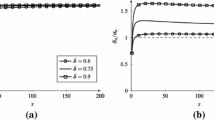Abstract
In traffic modeling, the computation of workload distributions plays a prominent role, since they influence the quality of service parameters. This paper deals with different ways to determine the workload distributions of a GI/GI/1 service system accurately. We discuss two different techniques, the polynomial factorization approach and the Wiener–Hopf factorization. These methods factorize the server system's characteristic polynomial to compute the workload. Starting with classical algorithms to obtain initial approximations, we enhance them using verification techniques to guarantee the correctness of the results.
Similar content being viewed by others
References
G. Alefeld and J. Herzberger, Introduction to Interval Computations (Academic Press, New York, 1983).
D. Bini and G. Fiorentino, Numerical computation of polynomial roots: MPSolve–version 2.0, FRISCO Report (1998).
M.L. Chaudhry, Alternative numerical solutions of stationary queueing-time distributions in discrete-time queues: GI/G/1, J. Opl. Res. Soc. 44(10) (1993) 1035–1051.
D. Fausten, W. Luther and G. Haßlinger, Verified computing of the stationary workload distribution of a GI/GI/1 server, in: Recent Advances in Circuits, Systems and Signal Processing, eds. N. Mastorakis and G. Antoniou (WSEAS Press, 2002) pp. 169–174.
W.K. Grassmann and J.L. Jain, Numerical solutions of the waiting time distribution and idle time distribution of the arithmetic GI/GI/1 queue, Oper. Res. 37 (1989) 141–150.
R. Hammer, M. Hocks, U. Kulisch and D. Ratz, Numerical Toolbox for Verified Computing I (Springer, Berlin, 1993).
G. Haßlinger, A polynomial factorization approach to the discrete time GI/ G /1 /(N) queue size distribution, Performance Evaluation 23 (1995) 217–240.
G. Haßlinger, Waiting times, busy periods and output models of a server analyzed via Wiener-Hopf factorization, Performance Evaluation 40 (2000) 3–26.
G. Haßlinger, Quality-of-Service analysis for statistical multiplexing with Gaussian distributed and autoregressive input modeling, Telecommunication Systems 16 (2001) 315–334.
http://www.math.uniwuppertal.de/wrswt/xsc-sprachen.html.
R. Klatte, U. Kulisch, A. Wiethoff, C. Lawo and M. Rauch, C-XSC (Springer, Berlin, 1993).
L. Kleinrock, Queueing Systems, Vols. 1, 2 (Wiley, New York, 1975/1976).
G. Latouche and V. Ramaswami, The PH/PH/1 queue at epochs of queue size change, Queueing Systems 25 (1997) 97–114.
D.V. Lindley, The theory of queues with a single server, Proc. Cambridge Philos. Soc. 48 (1952) 277–289.
M.F. Neuts, Matrix Geometric Solutions in Stochastic Models (Johns Hopkins Univ. Press, Baltimore, MD, 1981).
Author information
Authors and Affiliations
Rights and permissions
About this article
Cite this article
Fausten, D., Luther, W. & Haßlinger, G. Accurate Computation of Traffic Workload Distributions. Numerical Algorithms 37, 137–146 (2004). https://doi.org/10.1023/B:NUMA.0000049461.33333.5b
Issue Date:
DOI: https://doi.org/10.1023/B:NUMA.0000049461.33333.5b




